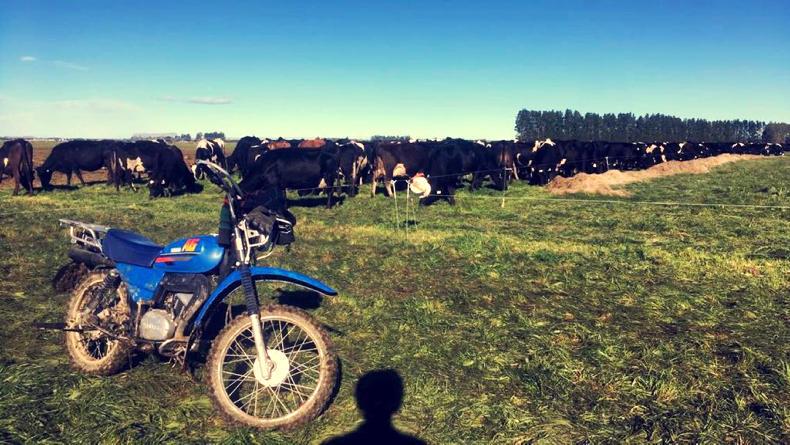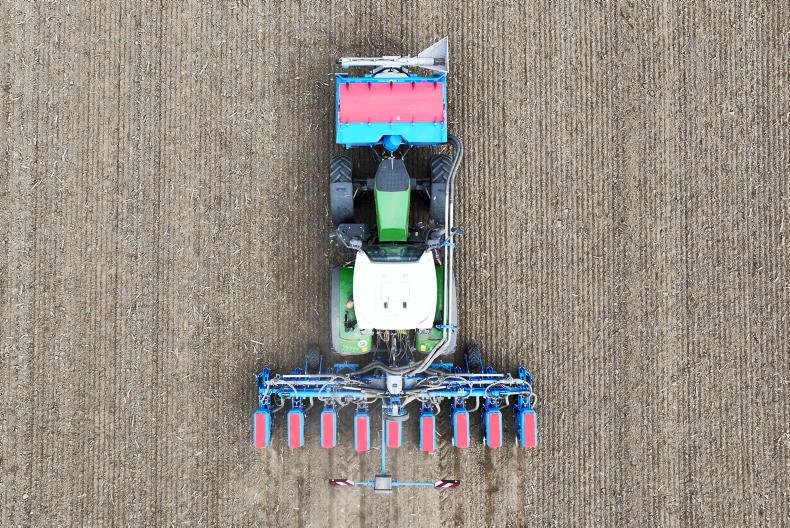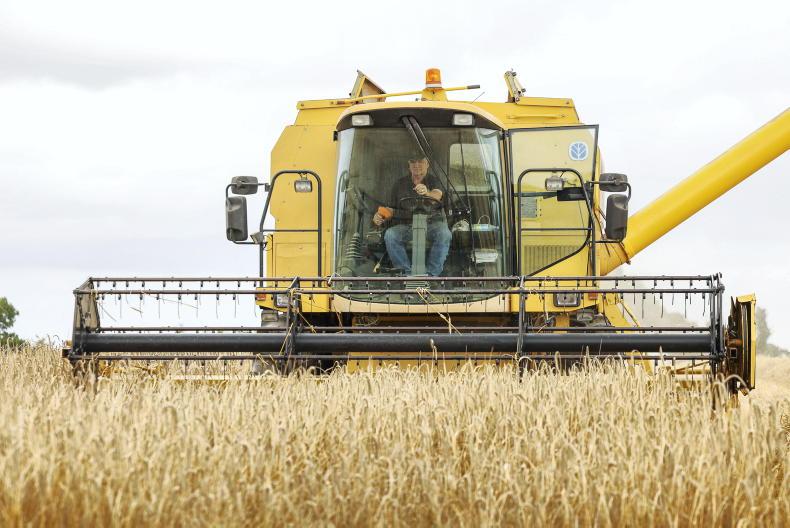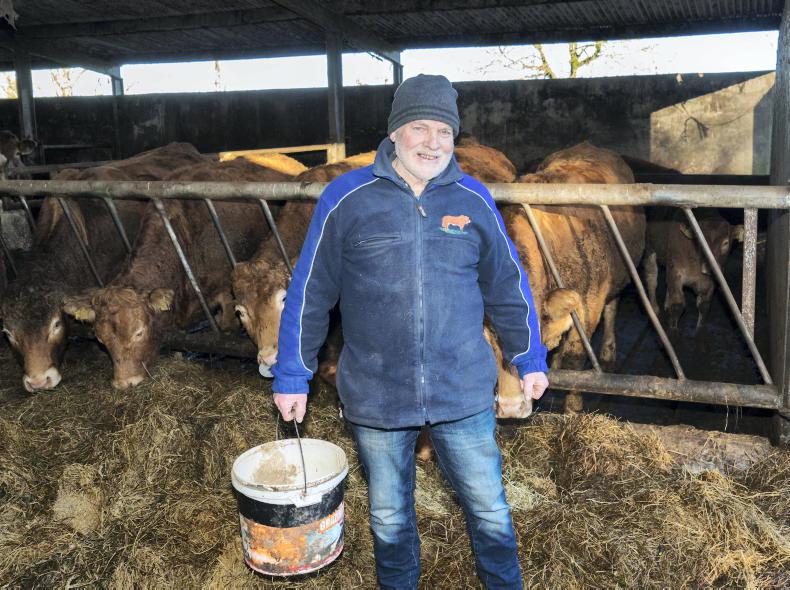
I’m kicking but I’m far from a field, my bike has no electric start. The LED lamp eventually begins to flicker, and I leave the choke on until I reach the first gate.
It’s 4.30am and my little Yamaha AG dirt bike is puffing along with the unmistakable two-stroke strimmer purr. It’s cow time and when I reach the field, in the pitch black, I’m fumbling for the handle of the bungee gate into paddock 12 because my bike has cut out, idling while cold.
The cows are far from sleepy though, the little crossbreds spring up and bounce towards the pass.
Within a week the weather has changed from -3°C during the nights to 20°C midday and applying sun cream has become a daily routine
The word ‘bóthar’ at home is for a road where two cows can pass. It’s easy to understand why they call the pass a ‘cow race’ here as they travel 10 abreast towards ‘the shed’, not the parlour mind you, because that’s where Kiwi’s get their hair cut.
Cow sheds don’t really exist over here, I’ve only seen one set of cubicles on the dozens of farms I’ve passed along the vast network of straight wide roads.
I arrived in July and there’s only been a couple of wet days since, the ground is firm within a day after rainfall and the lack of cubicle sheds hasn’t been an issue. Spring began at the start of September and soon after the heat followed suit.
Within a week the weather has changed from -3°C during the nights to 20°C midday and applying sun cream has become a daily routine.
My farm is about an hour from Christchurch, near Rakaia, on the Canterbury plains.
There’s not a hill to be seen except for the mountains in the distance, a big difference to the rolling Drumlins of Nobber I’m used to.
Cows are much easier to find when you can see the four corners of every field from the yard.
By mid-September 650 out of the 700 cows had calved, it’s a small number over here but it's keeping four of us busy. I’m working for Nathan and Erin Christian who are 50/50 sharemilkers, on 1 June they moved here after buying 700 crossbred cows from different herds across the North and South Islands.
A2 milk supplier
Something new to me on the farm was being an A2 milk supplier. Nathan explained to me that in ancient times all cows had a certain A2 protein gene which was mutated at some stage into an A1 gene through genetic selection for milk yield.
Holsteins mainly have the A1 gene, but many Jerseys still have the A2 Gene.
The cows bought for the farm had all been A2 tested and now all cows on the farm are homozygous A2-A2 which allows us to receive 20c more per kg of milk solids from Synlait our milk processor.
A2 milk is sold in the shops as a higher-priced product as it supposedly has certain health benefits and better digestibility. Normal milk price is strong this year with a Fonterra forecast of NZ$6.50/kg of solids as of 13 September.
Feeding
In terms of feeding, the farm is typical of a type-three model, over here grass-based v high-concentrate type systems are ranked from one to five - type one being that all forage is grown on the milking platform including silage for dry cow feeding.
Down the line bought-in forage amounts increase towards a type-five system where forage is brought in off the milking platform all year round and a high amount of concentrate is fed.
Our farm fits into the type-three system, we import feed for the ‘shoulders’ of the year due to the high stocking rate of 4.0 across the 170ha platform.
According to Dairy NZ the “five in system three feed is imported to extend lactation (typically autumn feed) and for dry cows”.
For the dry cow period we graze beet off-farm for the cows/maiden heifers and kale for the yearling heifers.
Silage was planned to be supplemented to the milkers but grass growth has been steadily meeting demand thanks to the mild spring. We recently cut three of the 27 paddocks for silage which was square-baled and wrapped this was approximately 11% of the platform.
Daily tasks
The daily tasks on the farm are similar to those at home but the mornings are much earlier, and we rarely work past half five in the evenings. Milking is done through a 42-bail rotary which is joked to be the oldest in Canterbury.
The recent addition of ACRs, retention and a teat sprayer has brought the platform up to date. One person can easily milk the first two herds on their own in the rotary and help arrives to manage the antibiotics and freshly calved cows at the end of each milking.
Most of the time milking and the wash is completed within three hours, leaving time during the day for calf collecting, feeding out, fresh cow drafting and all the other jobs that go on daily during calving season.
Breeding
Breeding is the next thought in everyone’s minds over here, at a pre-breeding talk in Ashburton by Dairyvets.nz ideas bounced round about heat detection, synchronising heifers and non-cycling cow treatment.
"Days in milk" were the buzzwords which drove every action while body condition scoring was also said to play a major role.
Movement of thin cows to a small once-a-day milking group showed great results last year in a simple trial on three herds by the local vets.
The thin cows managed to match the rest of the herd after scanning results were analysed.
We had our GoPros recording to scare our mothers at home with the snow-covered footage
Little was mentioned in terms of minerals, but Enda Hawe, an Irish man, still managed to stir the crowd when he suggested putting “holy water into the Dosatron” – the machine for adding minerals to the water trough system.
As calving draws to a close I’m looking forward to the breeding season and hoping the heat of the coming summer won’t be too strong. Unlike at home, drought won’t be a worry as irrigation is a feature of almost every farm around.
Pivots span the countryside and will soon be pumping out millions of litres daily from the meltwater of the mountain snow.
This means ski season is coming to an end, but I was lucky to be able to spend a couple of my days off on the slopes with other friends from the UCD dairy business gang.
We had our GoPros recording to scare our mothers at home with the snow-covered footage.
The days off always involve a trip to see another part of the island and the stunning New Zealand scenery doesn’t fail to disappoint even on the occasional foggy days of spring.
I’ve gotten a great opportunity to learn and practice the skills needed to improve efficiency and lower the cost of milk production at home, but will it all still work without the crossbreds?
Patrick Horgan is a third year UCD dairy business student from Nobber, Co Meath is currently on 20 weeks work placement in New Zealand until December.

I’m kicking but I’m far from a field, my bike has no electric start. The LED lamp eventually begins to flicker, and I leave the choke on until I reach the first gate.
It’s 4.30am and my little Yamaha AG dirt bike is puffing along with the unmistakable two-stroke strimmer purr. It’s cow time and when I reach the field, in the pitch black, I’m fumbling for the handle of the bungee gate into paddock 12 because my bike has cut out, idling while cold.
The cows are far from sleepy though, the little crossbreds spring up and bounce towards the pass.
Within a week the weather has changed from -3°C during the nights to 20°C midday and applying sun cream has become a daily routine
The word ‘bóthar’ at home is for a road where two cows can pass. It’s easy to understand why they call the pass a ‘cow race’ here as they travel 10 abreast towards ‘the shed’, not the parlour mind you, because that’s where Kiwi’s get their hair cut.
Cow sheds don’t really exist over here, I’ve only seen one set of cubicles on the dozens of farms I’ve passed along the vast network of straight wide roads.
I arrived in July and there’s only been a couple of wet days since, the ground is firm within a day after rainfall and the lack of cubicle sheds hasn’t been an issue. Spring began at the start of September and soon after the heat followed suit.
Within a week the weather has changed from -3°C during the nights to 20°C midday and applying sun cream has become a daily routine.
My farm is about an hour from Christchurch, near Rakaia, on the Canterbury plains.
There’s not a hill to be seen except for the mountains in the distance, a big difference to the rolling Drumlins of Nobber I’m used to.
Cows are much easier to find when you can see the four corners of every field from the yard.
By mid-September 650 out of the 700 cows had calved, it’s a small number over here but it's keeping four of us busy. I’m working for Nathan and Erin Christian who are 50/50 sharemilkers, on 1 June they moved here after buying 700 crossbred cows from different herds across the North and South Islands.
A2 milk supplier
Something new to me on the farm was being an A2 milk supplier. Nathan explained to me that in ancient times all cows had a certain A2 protein gene which was mutated at some stage into an A1 gene through genetic selection for milk yield.
Holsteins mainly have the A1 gene, but many Jerseys still have the A2 Gene.
The cows bought for the farm had all been A2 tested and now all cows on the farm are homozygous A2-A2 which allows us to receive 20c more per kg of milk solids from Synlait our milk processor.
A2 milk is sold in the shops as a higher-priced product as it supposedly has certain health benefits and better digestibility. Normal milk price is strong this year with a Fonterra forecast of NZ$6.50/kg of solids as of 13 September.
Feeding
In terms of feeding, the farm is typical of a type-three model, over here grass-based v high-concentrate type systems are ranked from one to five - type one being that all forage is grown on the milking platform including silage for dry cow feeding.
Down the line bought-in forage amounts increase towards a type-five system where forage is brought in off the milking platform all year round and a high amount of concentrate is fed.
Our farm fits into the type-three system, we import feed for the ‘shoulders’ of the year due to the high stocking rate of 4.0 across the 170ha platform.
According to Dairy NZ the “five in system three feed is imported to extend lactation (typically autumn feed) and for dry cows”.
For the dry cow period we graze beet off-farm for the cows/maiden heifers and kale for the yearling heifers.
Silage was planned to be supplemented to the milkers but grass growth has been steadily meeting demand thanks to the mild spring. We recently cut three of the 27 paddocks for silage which was square-baled and wrapped this was approximately 11% of the platform.
Daily tasks
The daily tasks on the farm are similar to those at home but the mornings are much earlier, and we rarely work past half five in the evenings. Milking is done through a 42-bail rotary which is joked to be the oldest in Canterbury.
The recent addition of ACRs, retention and a teat sprayer has brought the platform up to date. One person can easily milk the first two herds on their own in the rotary and help arrives to manage the antibiotics and freshly calved cows at the end of each milking.
Most of the time milking and the wash is completed within three hours, leaving time during the day for calf collecting, feeding out, fresh cow drafting and all the other jobs that go on daily during calving season.
Breeding
Breeding is the next thought in everyone’s minds over here, at a pre-breeding talk in Ashburton by Dairyvets.nz ideas bounced round about heat detection, synchronising heifers and non-cycling cow treatment.
"Days in milk" were the buzzwords which drove every action while body condition scoring was also said to play a major role.
Movement of thin cows to a small once-a-day milking group showed great results last year in a simple trial on three herds by the local vets.
The thin cows managed to match the rest of the herd after scanning results were analysed.
We had our GoPros recording to scare our mothers at home with the snow-covered footage
Little was mentioned in terms of minerals, but Enda Hawe, an Irish man, still managed to stir the crowd when he suggested putting “holy water into the Dosatron” – the machine for adding minerals to the water trough system.
As calving draws to a close I’m looking forward to the breeding season and hoping the heat of the coming summer won’t be too strong. Unlike at home, drought won’t be a worry as irrigation is a feature of almost every farm around.
Pivots span the countryside and will soon be pumping out millions of litres daily from the meltwater of the mountain snow.
This means ski season is coming to an end, but I was lucky to be able to spend a couple of my days off on the slopes with other friends from the UCD dairy business gang.
We had our GoPros recording to scare our mothers at home with the snow-covered footage.
The days off always involve a trip to see another part of the island and the stunning New Zealand scenery doesn’t fail to disappoint even on the occasional foggy days of spring.
I’ve gotten a great opportunity to learn and practice the skills needed to improve efficiency and lower the cost of milk production at home, but will it all still work without the crossbreds?
Patrick Horgan is a third year UCD dairy business student from Nobber, Co Meath is currently on 20 weeks work placement in New Zealand until December.












SHARING OPTIONS